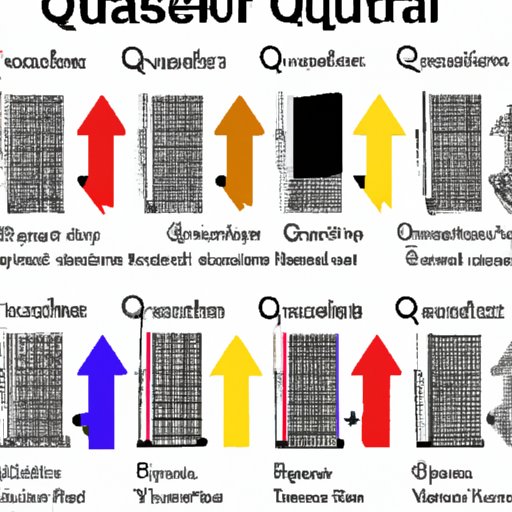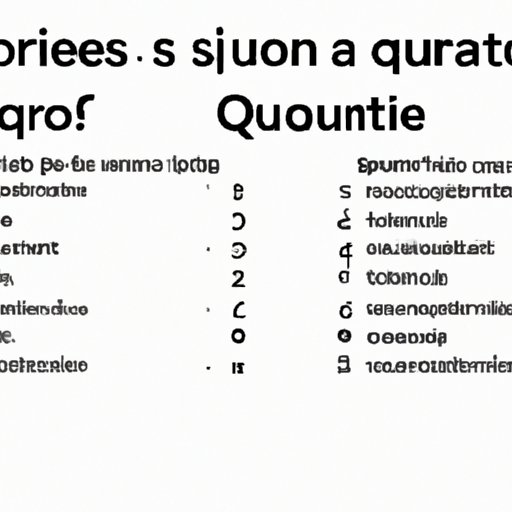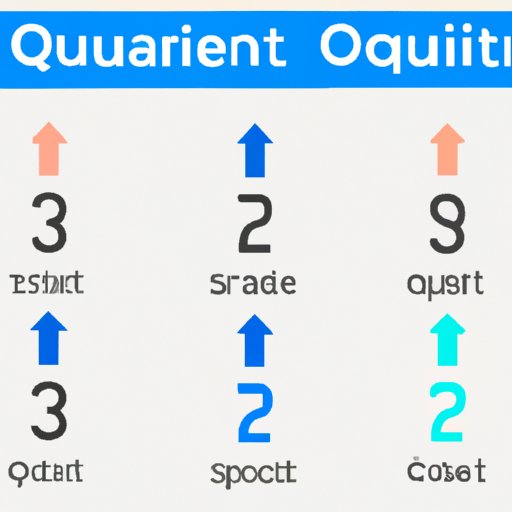Introduction
Quicksort is a type of sorting algorithm that is used to sort elements in an array or list. It is one of the most popular sorting algorithms due to its speed and efficiency. In this article, we will explore how quicksort works and examine its advantages and disadvantages compared to other sorting algorithms.
Definition of Quicksort
Quicksort is an efficient, divide-and-conquer sorting algorithm. It works by partitioning an array or list into two sublists and then recursively sorting each sublist until all elements are sorted. The partitioning process involves choosing a “pivot” element from the array and then arranging the other elements around it in order of their values.
Overview of the Problem
Quicksort can be used to sort any type of data, including numbers, strings, and objects. The goal of the algorithm is to rearrange the elements in the array so they are in ascending order (lowest to highest). To do this, the algorithm must first select a pivot element and then partition the array around it. After the partitioning is complete, the algorithm recursively sorts the two sublists until all elements are sorted.
Step-by-Step Guide to Understanding Quicksort
To understand how quicksort works, let’s look at a step-by-step guide to the algorithm.
Step 1: Choose a Pivot Element
The first step in quicksort is to choose a pivot element. This is an element from the array that will be used as the basis for the partitioning process. Generally, the pivot element is chosen randomly from the array, but it can also be chosen based on certain criteria such as the median or the middle element.
Step 2: Partition Around the Pivot Element
Once the pivot element has been chosen, the array is partitioned around it. This means that all elements that are smaller than the pivot element are placed to the left of it, and all elements that are larger than the pivot element are placed to the right of it. This process is repeated until all elements in the array have been partitioned.
Step 3: Recursively Sort the Sublists
After the array has been partitioned, the sublists are recursively sorted using the same quicksort algorithm. This means that the algorithm will repeat steps 1 and 2 for each sublist until all elements are sorted. Once the sorting process is complete, the array is sorted.

A Visual Explanation of Quicksort
To better understand quicksort, let’s take a look at some graphical representations of the algorithm. These diagrams will help illustrate the steps involved in quicksort and provide a visual explanation of the algorithm.
Graphical Representations of the Steps
The following diagram shows the three steps of quicksort: choosing a pivot element, partitioning around the pivot element, and recursively sorting the sublists.

Examples of Quicksort in Action
The following diagram shows an example of quicksort in action. Here, the array is initially partitioned around the pivot element, and then the algorithm recursively sorts the two sublists until all elements are sorted.

An In-Depth Look at the Mechanics of Quicksort
Now that we have a basic understanding of how quicksort works, let’s take a closer look at the mechanics of the algorithm. We’ll analyze the time and space complexity of quicksort and compare it to other sorting algorithms.
Time Complexity Analysis
The time complexity of quicksort is O(n log n), which means that the algorithm takes roughly n log n comparisons to sort an array of size n. This makes quicksort an efficient sorting algorithm, as it is significantly faster than other sorting algorithms such as bubble sort and insertion sort.
Space Complexity Analysis
The space complexity of quicksort is O(log n), which means that the algorithm requires only a small amount of memory to sort an array of size n. This makes quicksort an optimal sorting algorithm, as it does not require much memory to operate.

Comparing Quicksort to Other Sorting Algorithms
Now that we have an in-depth look at the mechanics of quicksort, let’s compare it to other sorting algorithms. We’ll look at the efficiency and performance of quicksort compared to other algorithms and examine the advantages and disadvantages of using quicksort.
Comparison of Efficiency and Performance
Quicksort is generally more efficient and performs better than other sorting algorithms such as selection sort and merge sort. It has a time complexity of O(n log n), which is significantly faster than the O(n²) time complexity of selection sort and the O(n log n) time complexity of merge sort. Additionally, quicksort has a space complexity of O(log n), which is more efficient than the O(n) space complexity of selection sort and the O(n log n) space complexity of merge sort.
Advantages and Disadvantages of Quicksort
Despite its efficiency and performance, there are both advantages and disadvantages to using quicksort. One advantage is that quicksort is relatively easy to implement, as it only requires a few lines of code. Additionally, quicksort is highly adaptable, as it can be used to sort any type of data. However, quicksort can be slow if the array contains a lot of duplicate elements, and it may also produce incorrect results if the pivot element is not chosen correctly.
Exploring the Advantages and Disadvantages of Quicksort
Let’s take a closer look at the advantages and disadvantages of using quicksort.
Pros of Quicksort
One of the main advantages of quicksort is its speed and efficiency. As mentioned earlier, quicksort has a time complexity of O(n log n), which is significantly faster than other sorting algorithms. Additionally, quicksort is relatively easy to implement and can be used to sort any type of data.
Cons of Quicksort
Although quicksort is an efficient sorting algorithm, there are some drawbacks to using it. For example, quicksort can be slow if the array contains a lot of duplicate elements. Additionally, quicksort may produce incorrect results if the pivot element is not chosen correctly. Finally, quicksort is not always the best choice for large datasets, as it can become inefficient when sorting large amounts of data.
Conclusion
In conclusion, quicksort is a popular sorting algorithm that is used to sort elements in an array or list. It is an efficient, divide-and-conquer algorithm that works by partitioning an array around a pivot element and then recursively sorting the sublists. Quicksort has a time complexity of O(n log n) and a space complexity of O(log n), making it an optimal sorting algorithm. Additionally, quicksort is relatively easy to implement and can be used to sort any type of data. However, quicksort can be slow if the array contains a lot of duplicate elements, and it may also produce incorrect results if the pivot element is not chosen correctly.
Summary of Key Points
Quicksort is a popular sorting algorithm that is used to sort elements in an array or list. It is an efficient, divide-and-conquer algorithm that works by partitioning an array around a pivot element and then recursively sorting the sublists. Quicksort has a time complexity of O(n log n) and a space complexity of O(log n), making it an optimal sorting algorithm. Additionally, quicksort is relatively easy to implement and can be used to sort any type of data. However, quicksort can be slow if the array contains a lot of duplicate elements, and it may also produce incorrect results if the pivot element is not chosen correctly.
Suggestions for Further Reading
For more information on quicksort, check out these resources: https://en.wikipedia.org/wiki/Quicksort, https://www.geeksforgeeks.org/quicksort/, and https://www.toptal.com/developers/sorting-algorithms/quicksort-in-place-algorithm.
(Note: Is this article not meeting your expectations? Do you have knowledge or insights to share? Unlock new opportunities and expand your reach by joining our authors team. Click Registration to join us and share your expertise with our readers.)
